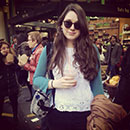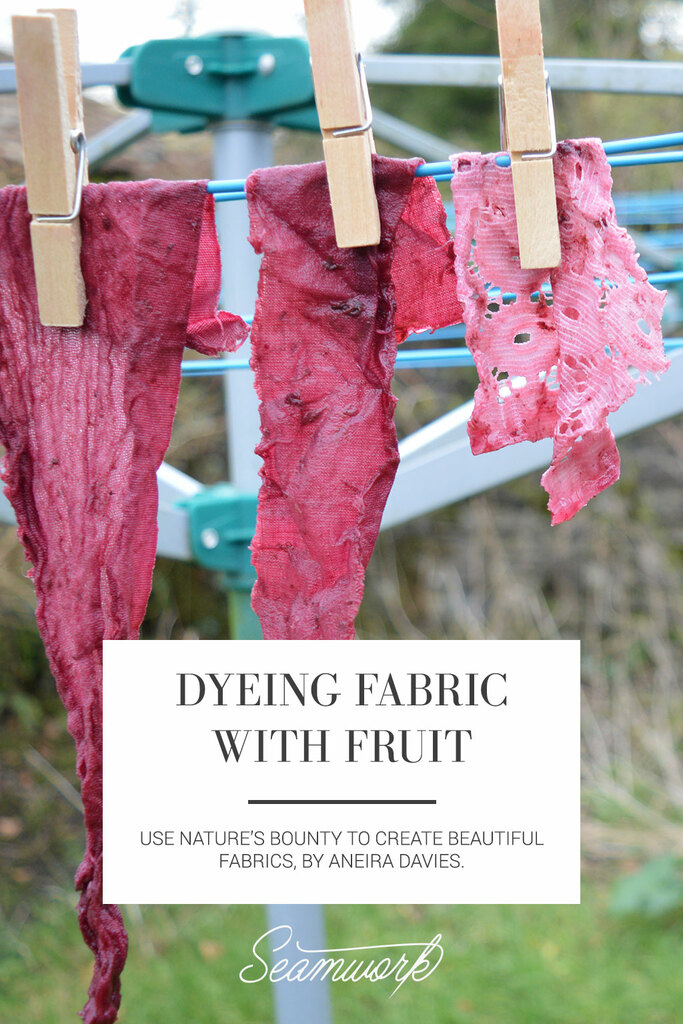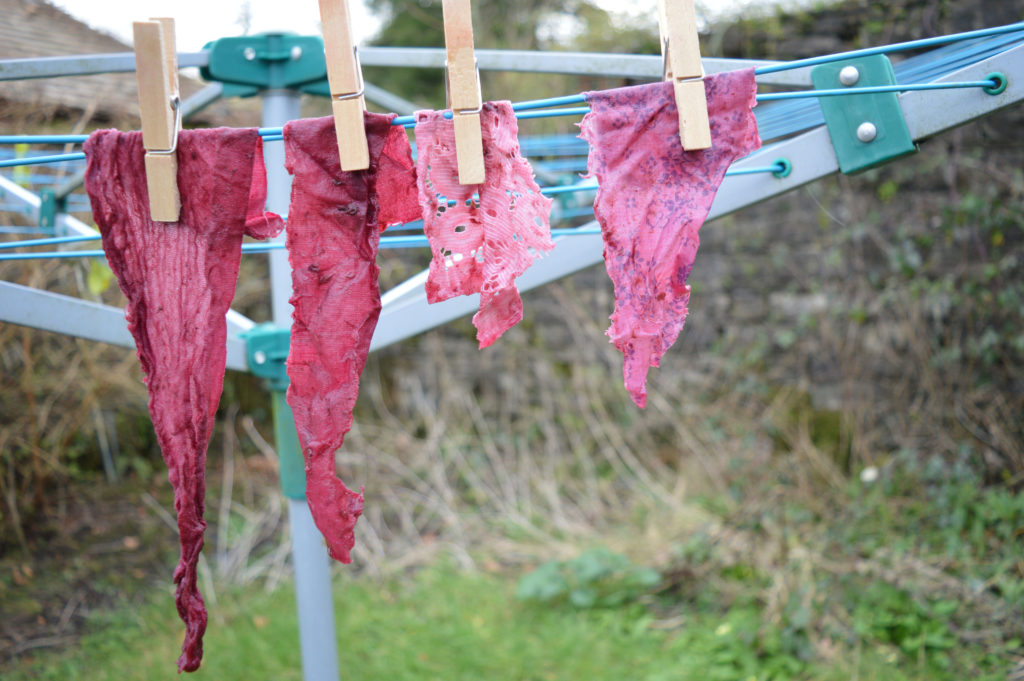
You might not be aware but there are lots of things that you already have around the house that can be used to make natural dyes, which can be used for dyeing faded clothing and upcycling plain fabric. For years people have used natural materials to dye their fabric, starting with a variety of plant-based dyes, such as woad, indigo, saffron, and madder. Fruits and vegetables are also great for creating natural dyes. Best of all, the process of natural dyeing is fun too!
In this guide, I will walk you through the fruit dyeing process. We’ll use a variety of fruits, so that you get a sense for the spectrum of results available from different fruit dyes. We’ll talk about using bleached versus unbleached fabrics, and how frozen fruit might affect results. I chose to use berries as they’re naturally staining fruit that give strong results.
Interest in the technique of natural dyeing has soared as people look for more natural ways to dye their fabrics, since synthetic dyes can often be harmful to the environment. Indigo dyed fabrics are now regularly sold in haberdasheries. Independent designers such as Phuongmai Nguyen, who runs ethical business Indigo Sew and sells eco-friendly and handmade quilts and cushions in the UK, uses naturally dyed fabrics in her work. “Synthetic dyes can be harmful to factory workers because of long-term exposure to the chemicals involved,” she says.
Phuongmai first started using natural dyes because of their designs. “Naturally dyed colors look and feel more authentic than synthetic dyes,” she says. Then she realized how they were made, and the process appealed to her even more. “Each fiber would also have its own beautiful backstory, from the dedicated craftsmanship of the making of the dyes from plants and minerals.”
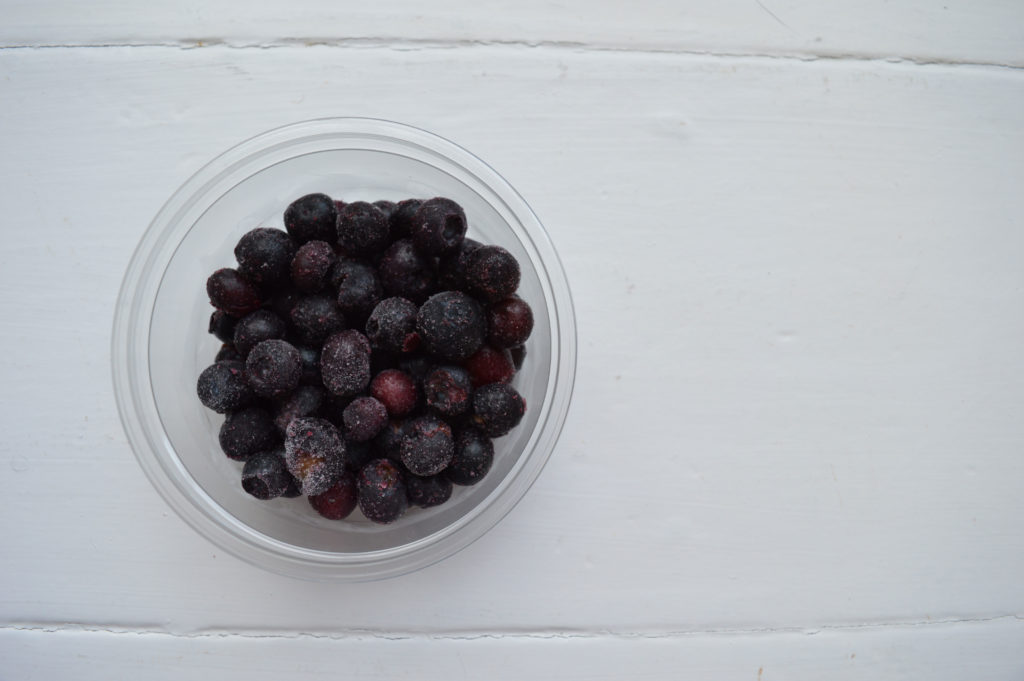
Frozen blackcurrants produce a lush color palette that can be created year-round.
Although any fruit, vegetable, or plant that can stain can be used as a natural dye, some do work better than others. I chose to use berries, as they stain quite easily—remember dripping those raspberries all over your t-shirt as a child? Different berries will produce different results, as I'll show you below.
As fruit tends to be seasonal, it might not always be possible to have fresh fruit on hand all the time. In season fruit is better for the environment, which is a concern for a lot of people who are interested in finding natural ways to dye. If that’s important for you, be sure to plan your dyeing accordingly. It’s also possible to use frozen fruit for satisfactory dye results. If you have fresh fruit on hand though, the fruit can be used straightaway and won’t need to be defrosted before using.
As an aside, you can certainly dye with vegetables; beetroot, onion skins, and spinach give strong colors. This tutorial, however, will only cover dyeing with berries.
More ideas
If you’d like to experiment with other natural dyes, here are other fruits and vegetables that will produce strong colors:
- Beetroot
- Onion skins
- Spinach
- Orange peel
- Kale stalks
- Damson
You Will Need
• 1 cup berries*
• ¼ cup salt
• Saucepan (note the dyes may stain your saucepan)
• Pegs (for hanging finished fabric up to dry)
• Fabric (I used unbleached calico, unbleached muslin, dyed cotton, dyed muslin, a few printed cottons, and several cotton blends)
• Gloves
*Depending on how much fabric you’re dying, you may need more fruit.
Note: I used five different fruit dyes for the samples in this article: fresh raspberries, frozen blueberries, frozen cherries, frozen blackcurrants, and frozen mixed fruits (redcurrants, blackcurrants, and strawberries). As you’ll see below, the different berries produce a spectrum of results.
A Word about Fabrics
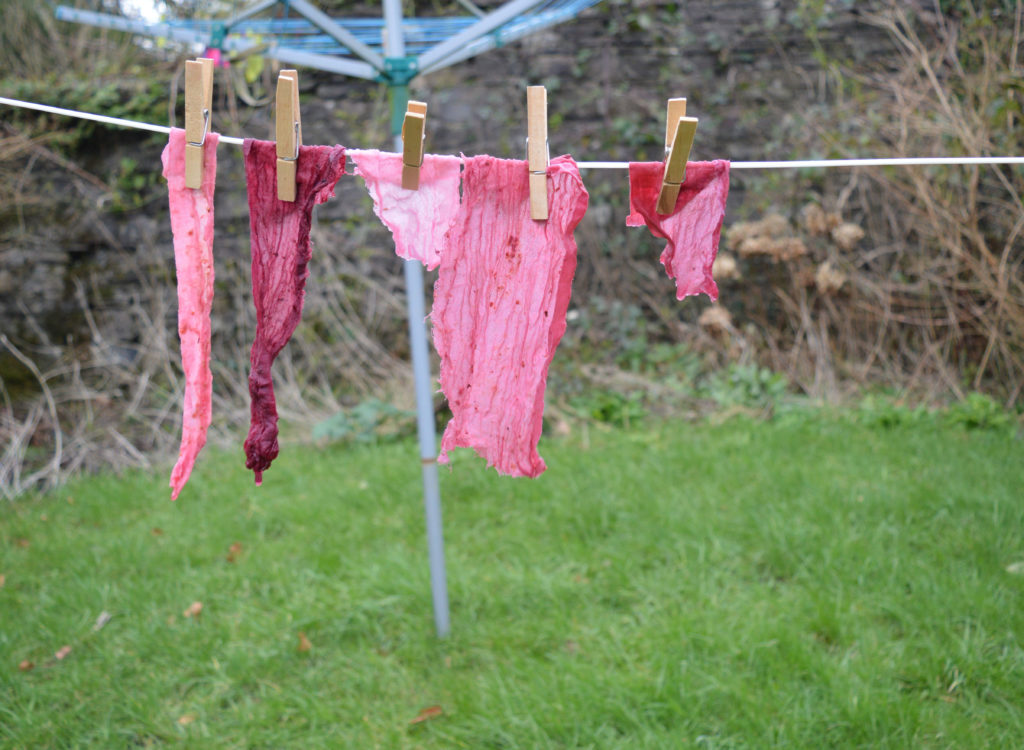
Fruit dyes will produce a range of results on unbleached muslin. Raspberry, blueberry, cherry, blackcurrant, mixed fruits (left to right).
Generally speaking, natural fabrics take dyes (natural or synthetic) the best, and will therefore produce the strongest colors. Furthermore, unbleached fabrics will produce stronger colors than pre-dyed fabrics, although you may have fun overdyeing pre-dyed fabrics to see what kinds of results you come up with. Depending on whether you prefer a soft, pale palette or like to sew with darker, more vibrant colors, you will want to select your fabrics accordingly. Also keep in mind that you can soak fabrics in the dye bath for a longer period of time to produce a brighter, deeper result. If it’s a rich color that you’re after, best to start with natural, unbleached fabrics like unbleached muslin or unbleached calico!
Prep
Put ¼ cup salt in 4 cups water. Add your fabric. If the water does not cover your fabric, continue adding water and salt in a 16:1 ratio until your fabric is submerged.
Bring the mixture to a boil, then let it simmer for about an hour. This creates a fixative that will help your fabric hold the color better, and which helps set the dye in the fabric.
Once finished, rinse your fabric in cold water and squeeze the excess water from it.
Dye
Put 1 cup of fruit and 4 cups of water in your saucepan. Bring the water to the boil, then add your fabric. If you have several yards of fabric, you will need to keep increasing the recipe, in a 1:4 fruit to water ratio, until your fabric is fully submerged.
Simmer gently for at least 20 minutes (I took mine off the heat after 30 minutes and left it to cool).
Take the saucepan off the heat and put it, with the fabric and the dyed water still in it, aside to cool.
Once the water is cooled you can take your fabrics out or leave them to soak up more color if desired. The longer the fabric is left in the water, the more of the color it will take on.
Your fabric can even be left in the cooled water overnight if you want. Remember that the final fabric will be lighter than what appears in the dye bath.
Once you are happy with the color of your fabric, put on gloves, take the fabric out of the water, and hang it outside to dry.
Individual Fruit Dye Results
I’ve detailed the color each fruit dye produces below, in general order of lightest to darkest. To help you understand the way dyes take to different fabrics, I’ve shown each dye in a variety of fabrics.
Raspberries
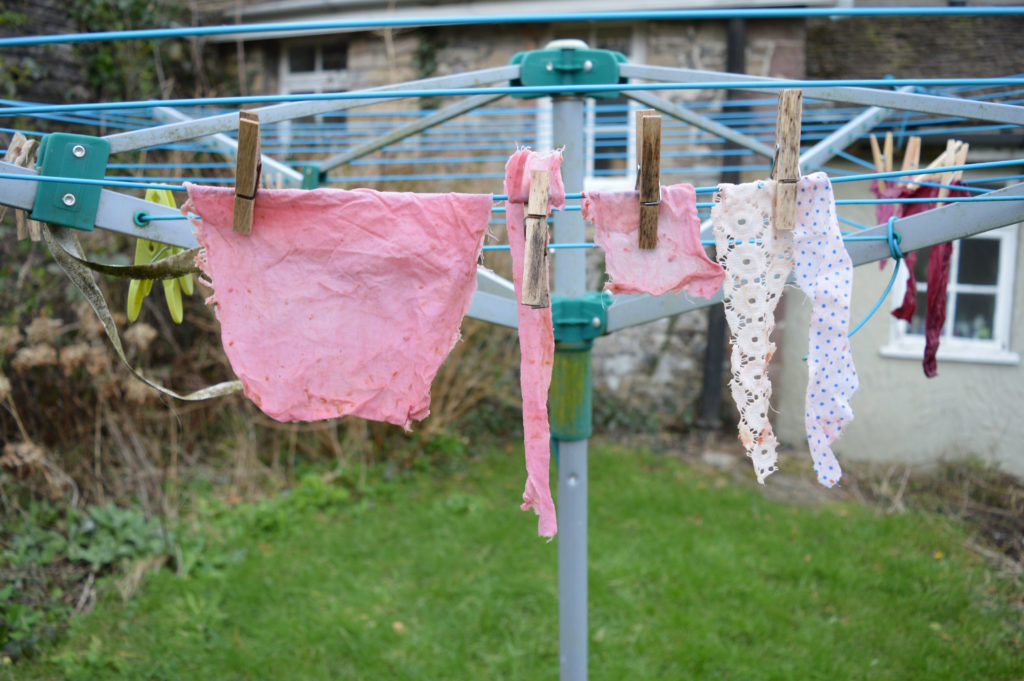
Raspberry dye on (left to right): unbleached calico, unbleached muslin, unbleached calico,
cotton blend, dyed cotton.
In general, raspberries will produce the palest colors of all the fruits mentioned in this article. They produce a very pale pink color on unbleached, pale fabrics. If you want a stronger color, soak the fabric in the dye mixture overnight.
Cherries
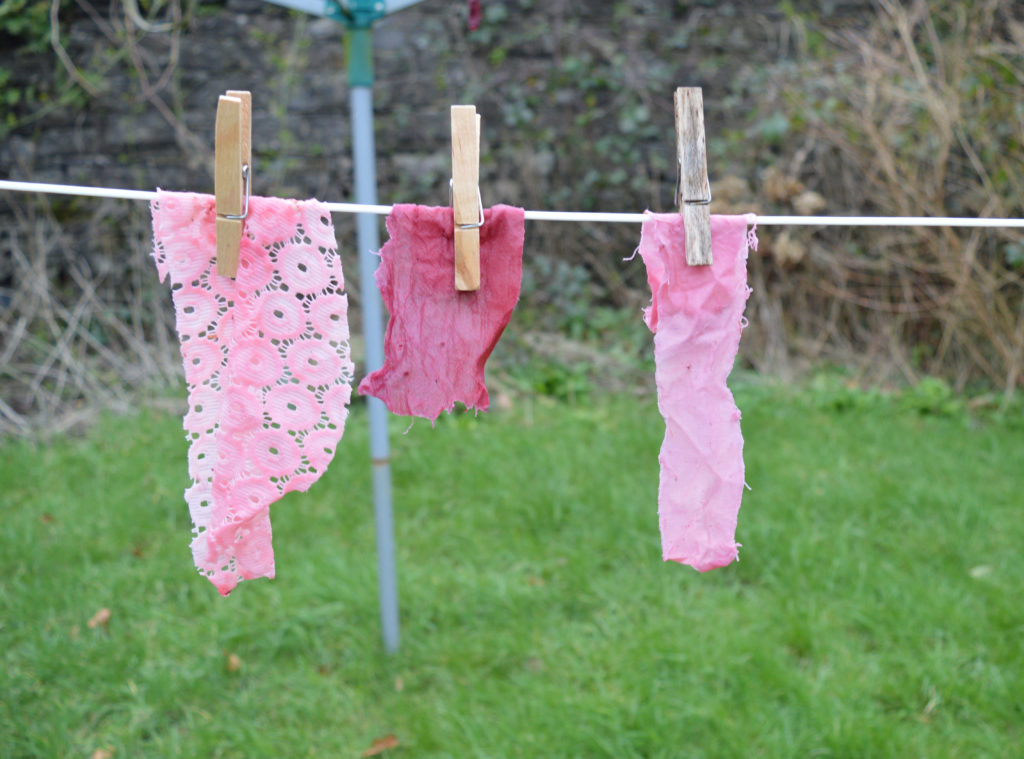
Cherry dye on (left to right): cotton blend, unbleached muslin, unbleached calico.
Cherry dye gives a lovely pale red color that is close to raspberry dye; as with the raspberry dye, fabrics dyed with cherries should be soaked overnight if you’d like a more vibrant result. Again, this dye takes the best to unbleached, pale fabrics.
Mixed Fruits
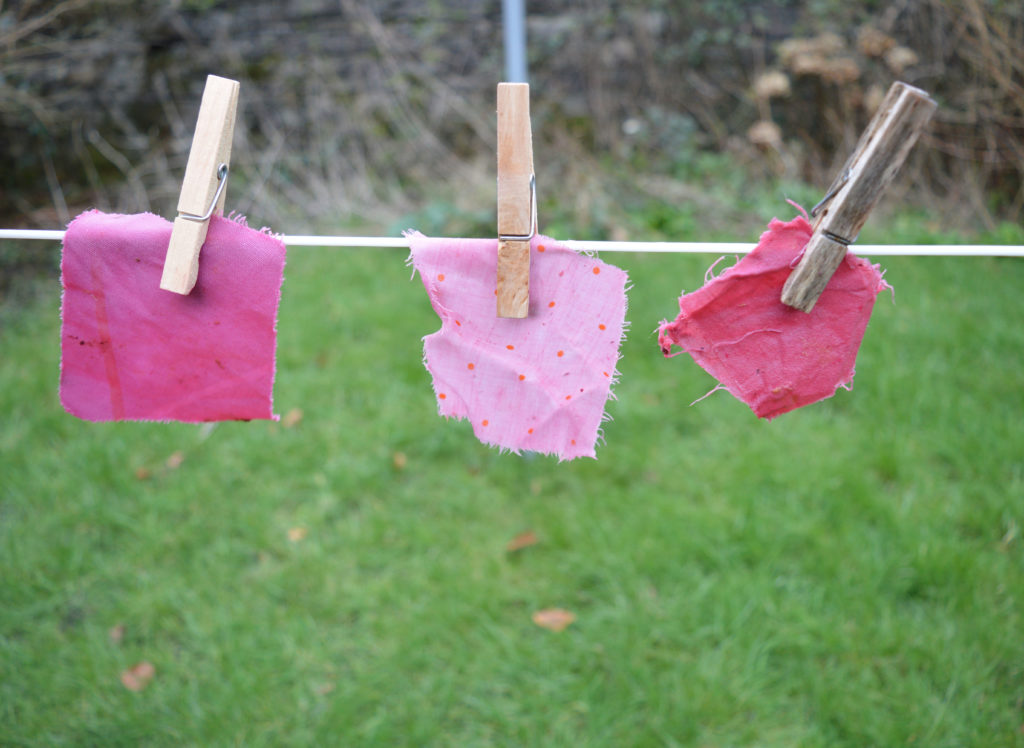
Mixed fruit dye on (left to right): dyed cotton blend, dyed cotton, unbleached muslin.
This combination is a bit of a wild card. A mixture of redcurrants, blackcurrants, and strawberries will produce a variety of colors on different fabrics. Colors will range from a pale pink to a dark pink, depending on the type of fabric used (unbleached fabrics tend to produce better results than dyed fabrics, for example). Great results overall! You may want to experiment with different fabrics and different combinations of fabrics. For example, if you want a paler pink, try swapping in some cherries or even raspberries. If you wish to add a purple tint to the fabrics, look to blueberries or blackcurrants (below).
Blackcurrants
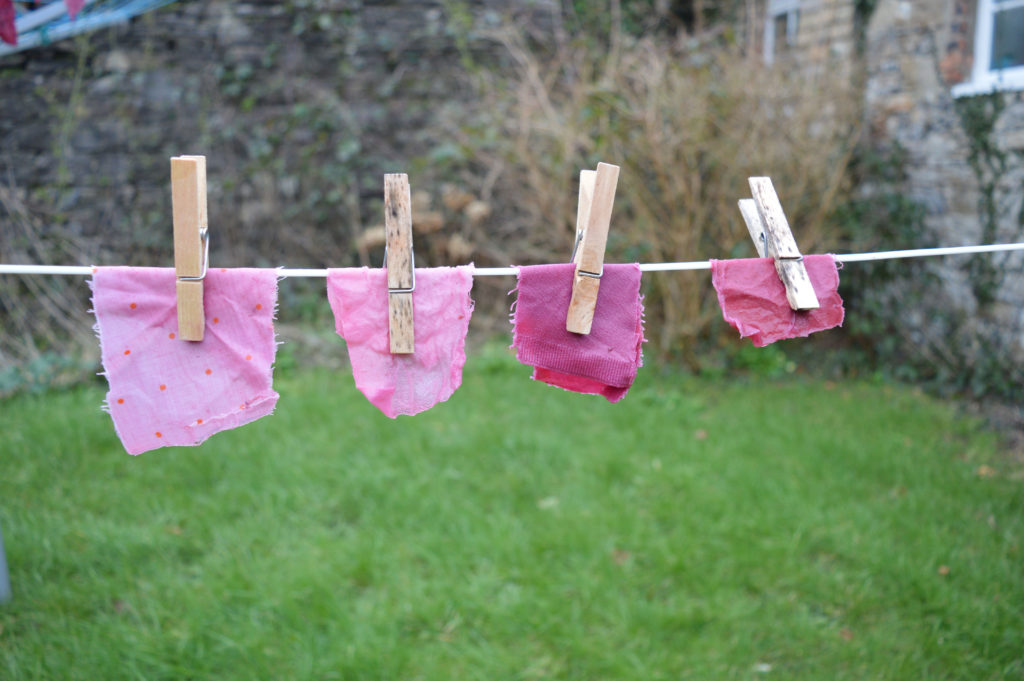
Blackcurrant dye on (left to right): dyed cotton, unbleached muslin, unbleached calico,
dyed muslin (base color mustard).
Black currant dye produces a range of colors, depending on the fabric, from a mid-range pink to a dark red on the unbleached muslin and calico fabrics. You’ll notice that the colors look similar to those produced by the mixed fruits dye, but blackcurrants are able to dye a wider variety of fabrics than the mixed fruits (for example, you can use this dye on already-dyed fabric and it will still turn out well, in contrast to the mixed fruits, which is best reserved for unbleached fabrics).
Blueberries
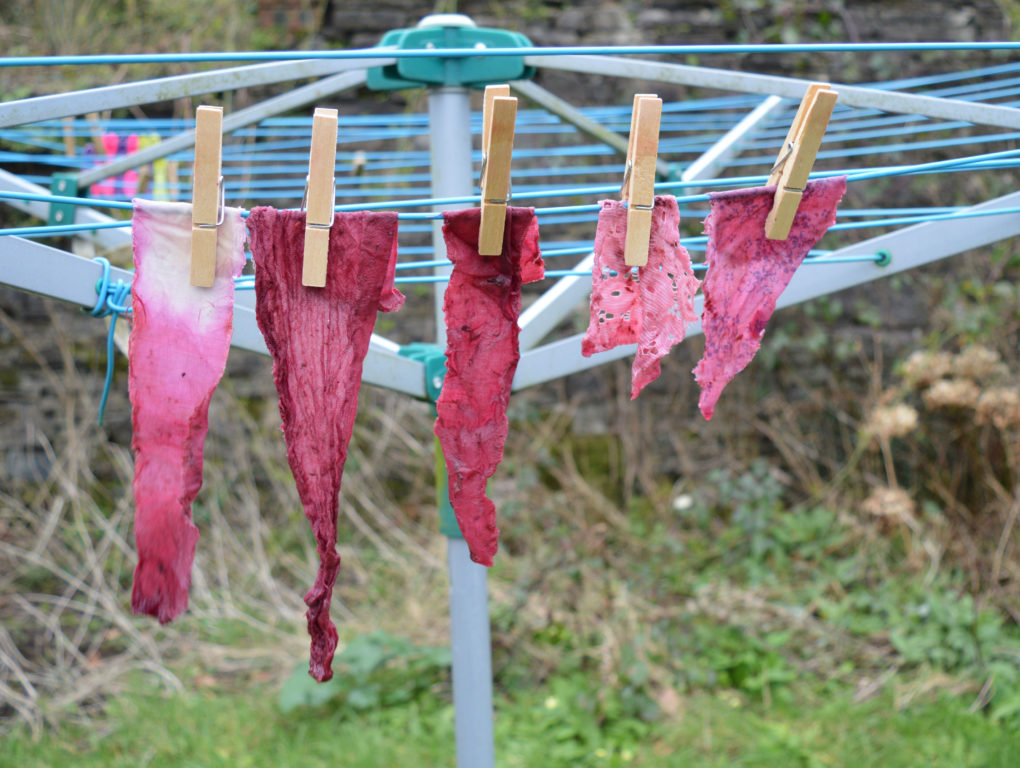
Blueberry dye on (left to right): unbleached muslin, unbleached calico, cotton blend, dyed cotton.
The blueberry mixture produces the strongest color of all the fruit dyes listed in this article. The difference between the raspberry and blueberry dyes, for instance, is quite obvious—the blueberry dye produces a darker plum color and a 30 minute soaking time is enough to create a strong color on a variety of fabrics.
Caring for Naturally-Dyed Fabrics
Since the fabric has not been dyed synthetically, the color will fade in time. However, there are several steps you can take to minimize this. Natural dyes are more likely to fade from using detergents, so it’s best to hand wash them if possible. This will ensure that the color lasts longer. If you have to wash your fabric in a washing machine, use a non-bleach based detergent and set the machine to a cold wash setting. Some natural dyes can also fade in the sunlight, so keep the fabric away from the sun!
With warm weather coming to the northern hemisphere, now is the perfect time to experiment with fruit dyes. If you’re in the southern hemisphere, a number of winter fruits and vegetables are great candidates for dyeing, as well. Depending on the fabric and fruit you use, the result may be soft and subtle or lush and vibrant. Either way, you’ll have a one-of-a-kind fabric ready for your next sewing project.
Additional Resources
For those interested in using vegetables for dyeing, check out this article by PopSugar.
A great tutorial on dyeing for children by Planet Science.
A list of plants you can use in natural dyeing and the colors they give.
If you wish to purchase garments made from naturally-dyed fabrics, Isabel Knowles uses indigo-dyed fabric in her work.
